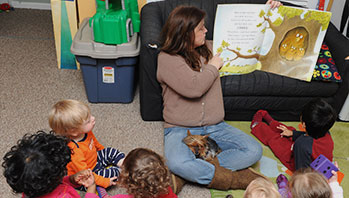- Toy Boat by Randal de Seve
- boat
- water
MA Standards:
Literature/RL.PK.MA.1: With prompting and support, ask and answer questions about a story or a poem read aloud.
Literature/RL.PK.MA.10: Listen actively as an individual and as a member of a group to a variety of age-appropriate literature read aloud.
Literature/RL.PK.MA.9: With prompting and support, make connections between a story or poem and one’s own experiences.
Head Start Outcomes:
Literacy Knowledge/Book Appreciation and Knowledge: Asks and answers questions and makes comments about print materials.
PreK Learning Guidelines:
English Language Arts/Reading and Literature 6: Listen to a wide variety of age appropriate literature read aloud.
Read Together: Toy Boat #1

© Commonwealth of Massachusetts, Department of Early Education and Care (Jennifer Waddell photographer). All rights reserved.
ELA Focus Skills: Concepts of Print, Compare and Contrast, Listening and Speaking, Make Connections, Story Comprehension, Vocabulary
Before You Read
Show children the book cover and ask them to locate the title. Read it aloud, tracking as you do. Ask children to describe what they see on the cover. Prompt with questions, such as,
- What do you think the book might be about?
- What might happen to the boat if the boy dropped the string?
- What do you think the boy will do with the boat?
Then do a picture walk with children.
- Encourage them to tell what they know about ocean water.
- Point out the changes in the way the water is drawn.
- Ask them to describe the water. (rough, still, and choppy)
As You Read
Hold the book so everyone can see the pages as you read slowly and with expression. Track the movements of the boat as it floats in the water by asking questions such as,
- What happens to the water when wind and rain begins? Why does the boat bob up and down on the waves?
- Point to the speedboat. Talk with children about how speedboats go very fast. Then ask, What do you think will happen to the boat?
- Pause on the page with the sailboats and ask, What does the water look like now? Do you think the boat might tip over now?
After You Read
Review the story. Ask questions such as,
- What was your favorite part of the story? Why?
- Was the little boat in trouble while it was floating on the water? How do you know?
- How is the way the boy's boat moves like your explorations when you put things in water?
Adaptation: If younger children have trouble concentrating, just read the first half of the book and return to the other half at a later time.
